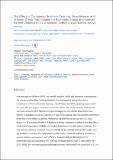| dc.contributor.author | Sarnquist, Clea C. | |
| dc.contributor.author | Ouma, Linda | |
| dc.contributor.author | Lang’at, Nickson | |
| dc.contributor.author | Lubanga, Chrisanthus | |
| dc.contributor.author | Sinclair, Jake | |
| dc.contributor.author | Baiocchi, Michael T. | |
| dc.contributor.author | Cornfield, David N. | |
| dc.date.accessioned | 2021-08-19T21:36:15Z | |
| dc.date.available | 2021-08-19T21:36:15Z | |
| dc.date.issued | 6/4/2018 | |
| dc.identifier.citation | 1. Sarnquist CC, Ouma L, Lang’at N, et al. The Effect of Combining Business Training, Microfinance, and Support Group Participation on Economic Status and Intimate Partner Violence in an Unplanned Settlement of Nairobi, Kenya. Journal of Interpersonal Violence. 2021;36(7-8):3903-3921. doi:10.1177/0886260518779067 | en_US |
| dc.identifier.uri | http://repository.amref.org/handle/123456789/105 | |
| dc.description | https://doi.org/10.1177/0886260518779067 | en_US |
| dc.description.abstract | Intimate partner violence (IPV) has myriad negative health and economic consequences for women and families. We hypothesized that empowering women through a combination of formal business training, microfinance, and IPV support groups would decrease IPV and improve women’s economic status. The study included adult female survivors of severe IPV. Women living in Korogocho received the intervention and women in Dandora served as a standard of care (SOC) group, but received the intervention at the end of the follow-up period. Women in the intervention groups (n = 82, SOC group, n = 81) received 8 weeks of business training, assistance creating a business plan, a small initial loan (about US$60), and weekly business and social support meetings. The two primary outcome measures included change in: (a) average daily profit margin, and (b) incidence of severe IPV. Exploratory analysis also looked at incidence of violence against children and women’s self-efficacy. Average daily profit margin in the intervention group increased by 351 Kenyan Shillings (about US$3.5) daily (95% CI = [172, 485]). IPV directed against participating women decreased from a baseline of 2.1 to 0.26 incidents, a difference of 1.84 incidents (95% CI = [1.32, 2.36]). Violence against children in the household in the prior 3 months decreased from 1.1 to 0.55 incidents, a difference of 0.55 incidents (95% CI = [0.16, 1.03]). Finally, the intervention appears to have increased self-efficacy scores by 0.42 points (95% CIs 0.13, 0.71). In a low-resource urban environment, employing three complementary interventions resulted in higher daily profit margins and lower IPV in the intervention compared with the SOC group. These data support the notion that employing multiple interventions concomitantly might possess synergistic, beneficial effects, and hold promise to address profound poverty and interrupt the devastating cycle of IPV. | en_US |
| dc.language.iso | en | en_US |
| dc.publisher | SAGE Publishing | en_US |
| dc.subject | Domestic violence | en_US |
| dc.subject | Child abuse | en_US |
| dc.subject | Sexual assault | en_US |
| dc.subject | Prevention of child abuse | en_US |
| dc.subject | Prevention | en_US |
| dc.title | The Effect of Combining Business Training, Microfinance, and Support Group Participation on Economic Status and Intimate Partner Violence in an Unplanned Settlement of Nairobi, Kenya | en_US |
| dc.type | Article, Journal | en_US |

